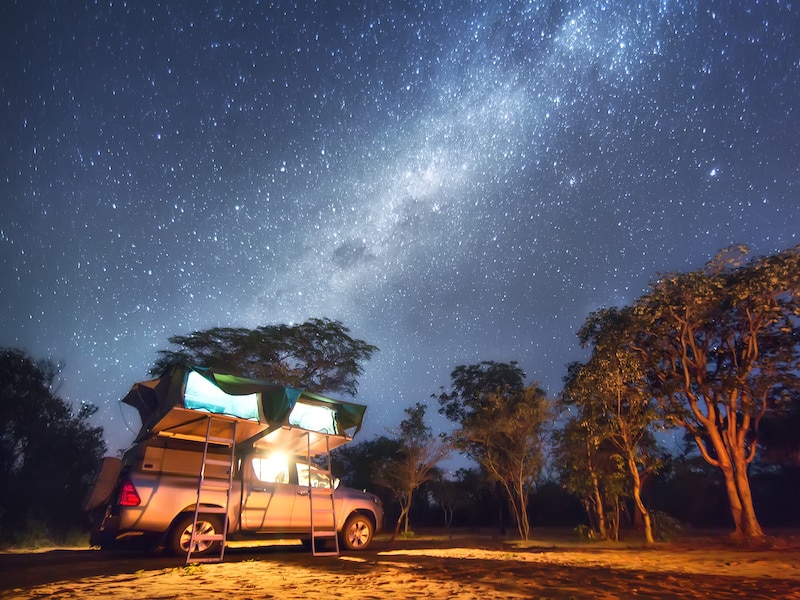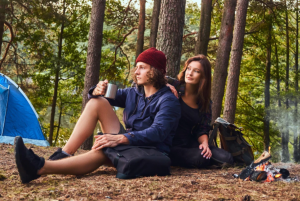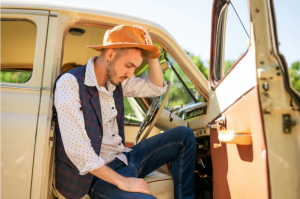Everybody loves the outdoors. Some people want to hike into the deep woods for several days and some just want to park in a convenient campsite. Car camping is a great way to take the hard work out of enjoying the great outdoors. It can be a convenient and easy way to enjoy outdoor grilling, lay out under the stars, and get the most out of your time away from the city or your usual grind.
What We'll Cover
- What is Car Camping?
- Advantages of Car Camping
- It’s a Good Introduction to Camping
- Car Camping Isn’t as Difficult
- Get the Camping Experience Without Roughing It
- What to Pack
- Flashlights and Headlamps
- Camp Kitchen and Food
- First Aid Kit
- Tent
- Sleeping Systems
- Extra Clothes
- Toiletries
- Where to Go
- What to Do
- Conclusion
If you want to get into car camping but have concerns about where to start, what to buy, and how to avoid common problems, you’ve come to the right place. Here, we’ll discuss how to get the most out of a casual camping trip and how to set up your campsite when car camping. We’ll explain how to avoid common mistakes and share some great ways to keep the cost at a minimum.
What is Car Camping?
If you’re asking yourself why you want to go camping with your car, you might be getting some pressure from others. Maybe you know some people who are dedicated hunters or more experienced outdoors people. You may feel using your car is lazy or somehow less noble than going RV camping or hiking into the deep woods.
Let’s just put those peer pressure related concerns to bed right away. For starters, it’s nobody’s business how you enjoy the outdoors. At least you’re doing it. From a practical standpoint, there are plenty of good arguments for car camping.
Advantages of Car Camping
There are plenty of good reasons to keep your car accessible when camping. They have to do with convenience, access to technology, cost effectiveness, and safety.
If you own a hatchback, the idea of camping in it just seems natural. It’s like your own tiny theater and nature can be your movie screen. You can just throw some blankets in the back and use it as a metal tent. Also, having your car nearby can give you the option to listen to music- which can be amazing in the woods. On a more practical tip- you may need access to your phone. Your car can help you be sure it’s charged in an emergency.
It’s a Good Introduction to Camping
Someone may have told you camping “the right way” means having a jeep or a camper or some other nonsense. The truth is, as long as you have enough equipment and the right equipment to be safe and comfortable, it doesn’t matter what kind of vehicle you use, or how close you stay to it. Using your car is a great way to keep expenses at a minimum. It allows you to use the least amount of gear and to get the most out of it. Using your car also makes it easier to protect your equipment from the elements, meaning your camping equipment will last longer. So when your outdoors purist friends are replacing their gear, you’ll still have your first set.
Car Camping Isn’t as Difficult
The added safety bonus of camping with your car cannot be underestimated. If you have failed to anticipate a dramatic change in the weather, your car can be a great asset. When you go car camping, a little rain isn’t a problem anymore. If the area you choose for your campground should become unsafe, having your vehicle handy is a good thing. Also, if animals decide to visit your campsite, retreating to your vehicle is always preferable to more violent alternatives.
Get the Camping Experience Without Roughing It
If you’re not an experienced bushcraft expert, aren’t in peak physical condition, or you just don’t want camping to be an Olympic sport, car camping makes sense. For the average camper, enjoying the outdoors is essentially entertainment. You want to relax, get away from your office, and just reconnect with nature. So why not make use of the obvious advantage of a motor vehicle?
Now that we have some verbal ammunition to use again the anti-car-camping folks, let’s talk about how to do car camping right.
What to Pack
Once again, the type and quality of camping equipment you will need will depend entirely on the following factors:
- How close you are to your vehicle
- Whether or not sleeping in your car is an option
- The comfort level of the location
- Weather conditions
- The local animal population
To abbreviate that list, you can just think in terms of how wild your campsite is. Generally, car camping is to be done in relatively tame locations. But any camping scenario can come with surprises, so you’ll want to be prepared for them. When you’re shopping for tents, sleeping bags, and other things, the quality and price of the gear you buy should increase the further you go from civilization, so to speak.
Car camping is a fairly casual way to enjoy the outdoors. Bring bags that are suitable for short hikes in the weather you expect to encounter. You shouldn’t need anything heavy unless you plan to hike far from your vehicle; if this is the case, you may want to consider vegan hiking boots or a compass for hiking. However, if that’s the case, are you really car camping?
Flashlights and Headlamps
Having reliable lighting is important for comfort and safety. Therefore, each camper should have a flashlight, camping lantern or solar camping lantern, or a headlamp. Headlamps are easy to use and always accessible. There are a lot of cheap headlamps on the market, which can be unreliable. Be ready to invest in quality lighting. If you don’t want to wear a headlamp, a decent flashlight that clips onto a belt is a reasonable alternative.
Camp Kitchen and Food
If money is tight, bringing your own pots and pans from home is a great option. Most of the time, your camp cooking is going to be fairly simple. However, if you want to get fancy with your grilling, bring whatever the recipe calls for. If you’re going to visit a dedicated campground, chances are they will have a built-in bbq camping grill or car camping stove that you can use. It would be a good idea to bring a grill brush in case the grill is not sufficiently clean for your liking. You might need to boil some water and scrub the grill down. Otherwise, small electric grills can be quite inexpensive, costing less than $20 in most cases. In the future, you may want something more impressive, but for your first car-camp, simple is best. Remember to bring a camping generator if you need power to run your appliances.
First Aid Kit
Every car should have a high-quality camping first aid kit under the driver or front passenger seat. Ideally, we should not even have to talk about first aid kits when car camping. But, if you do not have a first aid kit yet, now is the time to get one. Your best bet is to create your own high-quality first aid kit from pharmacy supplies. The most important items are those that can be used to stop bleeding, such as bandages and tourniquets, plus sterile gauze, elastic wraps, and disinfectants. If you have a bone fracture, sticks can be used with a bandage to stabilize the limb. After that, disinfectant, a suture kit, and pain killers are a good idea. If anyone in your party is allergic to bee venom, poison ivy, or any allergen you’re likely to encounter, have an epi-pen and medication ready.
Tent
Choose a tent that offers plenty of room to move, store clothing and anything else you may want right by your side as you sleep. Elbow room and easy-to-use doors and window screens are probably the most important features. Durability and resilience to weather are not big concerns since you have your vehicle to fall back on. Focus on elbow room, the view, and ease of use. If the weather is nice enough, you may not need a tent at all, especially if you bring a camping heater. If you want a place to sit, you may also want to bring a camping chair.
Sleeping Systems
A good rule of thumb for sleeping gabs is to have the most cold-resistant sleeping system you can find. High-quality sleeping bags can be a bit pricey, but they are a good investment. They could even save your life in a disaster. If you get too hot in your sleeping bag, you can always open it up a little. Another good feature is a bag that closes up around your face. This can make mosquitoes easier to deal with should they show up to the party. A square-nosed shovel and a tarp are good for flattening the ground where you’ll be sleeping and keeping bugs away.
Extra Clothes
As always, bringing enough clothes to dress in layers is a good idea. You want a selection of clothes based around your activities and the most likely climate scenario. The most important thing is comfort and mobility. But you also want some backups in case your clothes get damaged or wet. Plastic bags are a good idea in case mud or water get on your clothing or sleeping bags.
Toiletries
Even at a paid campsite, you should be prepared not to have access to running water. One water storage container of clean water, some washcloths, extra toilet paper, toothpaste and a toothbrush are your basic necessities. Also, be sure to bring trash bags so you can haul your trash out in case no bins are provided. Don’t be a litterbug.
Where to Go
When using your car as a camping aid, one of the first questions you want to answer is, how close to my car do I want or need to be? Do you expect to sleep in your car (hatchback owners)? Do you expect to sleep near your car? Or do you just want to have your car within a few minutes’ walk? The answer to this question will determine where you can camp comfortably, as well as how much and what kind of gear you may need.
In general, car campers will want to seek out a national park, a dedicated campground, or private property (obviously your own or that of someone you know).
Whether you’re camping near your home, or are camping as part of a longer road trip, look up campgrounds in the area. What you want is something where car camping is clearly legal, common, and where there are staff who take payment at the gate, the reason being when camping with your car, you need the protection of normality. Camping in cars is illegal in a lot of areas. It can also attract people who may disturb you or even try to do you harm if you are camping in a place where it isn’t normal. For these reasons, we always recommend using dedicated campgrounds.
Since car camping is always about convenience and cost effectiveness, using a paid campground gives you lots of what you’re looking for. You’ll get a designated spot to camp in. This spot will most likely have a bbq grill, some benches, and an area where you can easily make a fire.
Best of all, you’ll be able to have your car within a few feet of you. Perhaps most importantly, there will be a dedicated fire pit. This shows you are permitted to make a fire. Sometimes, making a fire can be a big question in more open settings. If the weather has been too dry to build a campfire safely, the campground staff should make it clear at the gate.
There are lots of places where camping is common, but there are not dedicated camping grounds with staff and prefabricated amenities such as described above. In these cases, you should be fine. Anyplace where car camping is common is probably safe. Just use your best judgment and talk to others in the area, if possible.
You may have to park along the road and hike in for a few minutes. This might no longer be “car camping” in your mind, which is why we mention it. You will also lose the certainty of knowing where it’s okay to cook and start fires. On the upside, you will enjoy a slightly more authentic camping experience. The one thing to keep in mind is, the farther from your car you are—or the deeper you bring your car into the woods—the more gear you will need. Not only that, but your gear will need to be of a higher quality.
What to Do
Car camping is a relaxing and casual way to enjoy the great outdoors. Remember, you’re not testing your skills, and you shouldn’t take unnecessary risks. If you want to take camping more seriously, but lack experience, car camping can be a great way to start. Enjoy yourself, respect nature, respect other campers, and don’t forget to look up at the stars. If you’re at a loss as to how you might spend your time, here are a few ideas.
Go Hiking
Now that you’re in the great outdoors, why not have a look around? Follow any trails you might find. Pack a few snacks and make an afternoon of it. Bring a camera if you’re so disposed and see if you can snap a few keepers. You might just have found yourself a new hobby!
Cook Campfire Meals
If you think cooking at home is fun, try cooking over an open campfire. Best of all, if you’re a bit of a foody, you might acquire some impressive new skills.
Stargaze
A clear view of the night sky is pretty rare. Be sure to look up if the sky is clear and be reminded of the endless glory and splendor, which sits right over our heads.
Watch a “Drive-In” Movie
If the weather isn’t friendly, or if your rustiness has been pushed to its limits, watch a movie on your tablet computer or mobile phone. You might find that nature and technology are not always at odds with each other.
Conclusion
Now that we’ve got your next big adventure sorted, there are a few things to keep in mind while you’re out there.
If you bring in trash, take it out. Don’t leave burning embers in your campfire. And don’t rinse your toothbrush in the river. For starters, you’re polluting unnecessarily. Also, the water may have dangerous microscopic organisms living in it.
Most camps have quiet hours. Also, if there are other campers near you, understand that nobody wants to hear your music. If you use your car stereo to enhance the experience, keep it low. If you’re camping with your dog or other pets, try to keep them away from other campers.
The basic rule of enjoying the outdoors is to leave it in as close to untouched condition as possible—or better.
The responses below are not provided, commissioned, reviewed, approved, or otherwise endorsed by any financial entity or advertiser. It is not the advertiser’s responsibility to ensure all posts and/or questions are answered.


![Tips to Go Camping With a Toddler [Different Weather]](/assets/images/375a17532f44c72a41d33b1008823cf3.png)


